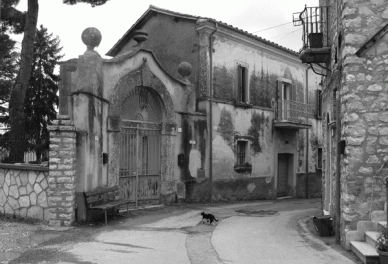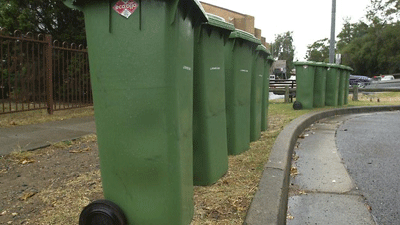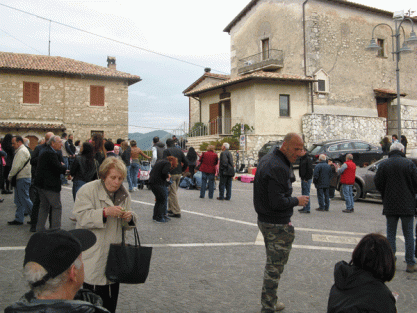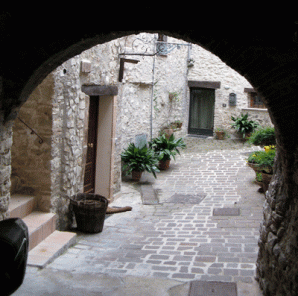La mappa, la spiegazione.
The brochure is printed — now to distribute them!

L’incontro è «un racconto da camminare», per così dire, un modo da vedere il paese attraverso un evento immaginato. Il racconto sarà pubblicato nei vari punti del borgo in cui l’azione si svolge
Allora, come scegliere i luoghi?
Ho scelto i luoghi mentre ideavo il racconto. Era importante che la passeggiata non ci voglia molto tempo, che l’itinerario debba essere semplice, che la mappa sia chiara, e che la passeggiata inizi e finisca nel centro sociale nel paese, vicino ai bar Micarelli e Daff.

5. Palazzo Filippi
Alcuni dei luoghi erano scelte ovvie: la Piazza del Municipio (1), la Chiesa dei Santi Domenico e Michele (10), il Palazzo Filippi (5). Questi sono i luoghi più importanti nel paese. Ho dovuto scegliere la nostra residenza, il Palazzo del Gatto (2), che si trova la metà strada tra la piazza e il centro storico.
Il palazzo era costruito nel 1891, quattro decenni dopo il racconto è ambientato, ma fortunatamente c’è un altro palazzo dietro al Palazzo del Gatto. Questo è più vecchio e quindi diventa la casa del personaggio, Capitano Bassetti.
A metà del racconto, si cammina nei vicoli stretti del centro storico (5, 6) e poi si cammina al piede della Strada della Fonte (7, 8), dove c’è un’altra vista meravigliosa. Per terminare il racconto si torna, attraversando il centro storico (9), alla chiesa dei Santi Domenico e Michele (10), dove il racconto si conclude. Non ho potuto scrivere il racconto come un giro più semplice senza interrompere la storia.
C’è solo un luogo inventato: un fienile derelitto in via Circonvallazione. Cercavo un edificio che sarebbe immaginato come «una stalla infestata di fantasmi» ma questo fienile non poteva mai state «una stalla» perché si situa sul lato di una collina. Così, «la stalla infestata» è diventata «il porcile infestato», pieno di porci terrorizzati una volta.
Ci ho messo 15 minuti per fare la passeggiata, così penso che ci voglia un’ora e più per «camminare il racconto» che è circa 10,000 parole. Va bene, mi sembra che nessuno a Casaprota sia in fretta!
The project (see post#1) results in a story being physically published in those parts of the town in which the action of the story takes place. Reading begins a process of “walking the story”, marking out the place of Casaprota through this imagined event. I choose the sites for the story as I mapped out the narrative. Some of the sites chosen were distinctive, while others could be interchangeable, where multiple sites were appropriate.
My brief for walking the narrative included that it couldn’t take too long, otherwise people wouldn’t do it; that it couldn’t be confusing; that hopefully the walk would be a loop around the town, and that the map that guides the reader should be easily recognisable. It was most important that the walk began and ended in the social centre of the town, conveniently next to Micarelli’s bar and bar Daff.
So some sites chose themselves: the Piazza del Municipio (1) and the church of San Domenico and San Michele (10), which fronts onto the piazza, and in the centre of the original town (the centro storico), the Palazzo Filippi (5) with its dominant tower, (dating from 1200), was another “must”.

2. Palazzo del Gatto (with cat)
I felt I had to use the Palazzo del Gatto (2), which is the home of the SabinARTi resident artists, and is conveniently located halfway between the Piazza del Municipio and the Palazzo Filippi. That turned out to be a small problem, as the building wasn’t constructed until 1891, well after the period in which the story is set. But behind the palazzo there is another, that existed at the time, so that became my focus. I simply dropped the name “Palazzo del Gatto”.

6. Mario finds Alice…
Leaving the piazza we pass the Palazzo del Gatto, head onto the back entrance of the once productive gardens of the Palazzo Filippi. Halfway through the story we find ourselves in the narrow alleys of the centro storico (5 and 6), we head out again to take in the fabulous views for the denouement (7 and 8), and then head back through the centro storico for one short scene (9) before the tale comes to its conclusion on the steps of the main church, again with some superb vistas.
I couldn’t get a complete loop, shuffling the sites would have upended the narrative flow, but the resultant path is not at all confusing.

7. “The haunted pigsty”
There is only one completely invented site, an abandoned farm building (there are many in the region) that I have imagined as haunted. My original vision was for haunted stables, and there are ruined stables in the gardens of the Palazzo del Gatto and probably elsewhere, but the building I had to choose could never have been imagined as stables, it is on the side of a hill, so it has become a derelict pigsty, the fictional home of terrified pigs.
Walking the route takes me 15 minutes, and reading the story, (it’s about 10,000 words) will take it to an hour plus, I suspect, and that’s fine here, the people of Casaprota are not in a hurry.
This week began with a visit to one of the most remarkable places here (in a region full of remarkable places). Il nido del falco (Falcon’s nest) is, as the name suggests, high up, and has commanding views the Sabina landscape. There is an old three-storey casalore (isolated house in the mountains) that sits against the hill and gazes out over the visual splendour of the Sabine hills. (I forgot to ask Adriano, our host, how old it is, but I suspect it’s an eighteenth century building.)
Adriano de Cupis is an appassionato of Giuseppe Garibaldi, and that was the reason for our visit. ‘Garibaldini’ fighters are central characters in the story for Casaprota, L’incontro. Adriano is a the great grandson of Filippo de Cupis, close friend and fighter with Garibaldi, and is the founder of the wonderfully named Garibaldini del terzo Millennio, (the Garibaldi of the third millennium), and the custodian of many original documents and memorabilia from the period, including photos and original letters from Garibaldi.
Diorama with Filippo de Cupis (far left), Garibaldi (partly obscured) and Anita Garibaldi.
The story of the discovery of this treasure trove of historical material is told in Adriano’s book Il cassetto chiuso (Portofranco 2011), the story of a locked and secret drawer, that was only opened after his father’s death to reveal its amazing contents. This is the sort of material that is normally in national archives, available only to accredited researchers, but there we were examining these originals in this beautiful old house. Yes, I was blown away by it (and apparently that was obvious!) It was way too much to take in with just one visit.
What did I learn? I have been developing a far greater appreciation of Garibaldi over some time, so much of what I learnt on Monday reinforced what I already felt I knew, that is, the importance of ideals in the story of the Risorgimento. Garibaldi’s vision for Italy was of a republican Italy dedicated to liberty and social justice, and I wonder whether there is some embarrassment today about that. There has been some concerted efforts to denigrate Garibaldi in Italy over recent decades apparently, especially from the political right. Is it that idealism, optimism and altruism sit so at odds with the cynicism of contemporary politics, that is makes us embarrassed by the contemporary absence of thinkers and visionaries?

Susanna and I join the Garibaldini…
There is, happily, a video about il nido del falco on YouTube. https://www.youtube.com/watch?v=lNWsNo3MJYI
photos courtesy of Susanna Emili and Adriano de Cupis
Here are two of the containers for garbage and recycling used in Casaprota. The brown one is for organic waste which is collected twice a week, and the grey one is for non-recyclable waste and that is emptied once a week, all this for a household of four at the Palazzo del Gatto. Can’t help comparing that with the Australian wheelie bin, which is the size of an Italian bathtub.

Festeggiamo il primo Maggio in Australia, ma in date diverse secondo la provincia. In alcune è festeggiato il primo maggio, in altre nel marzo o ottobre.
In ogni caso è un giorno festivo, e ci sono sempre eventi sportivi, ma non sono consapevole di una città o un paese in Australia, dove si festeggia con cibo!
Non mi sorprende che tutto il cibo era locale e che era servito semplicemente. Al centro del tavolo erano le fave. Non abbiamo le fave come queste in Australia, solo un tipo di fave molto più corte, che non mangiamo crude, per quanto ne so. Trovo le fave crude di Sabina davvero deliziose e una combinazione perfetta con il pecorino, il vino e il pane con olio d’olive, però mi sorprende che il divertimento erano anche locale: una banda di ottoni, (notevole per un piccolo paese) e il duetto, Bertoldo e compagna che, con solo alcuni oggetti di scena, erano affascinanti, non solo per i bambini ma anche per noi adulti.
Avere una festa in cui tutto è locale, mi sembra perfettamente normale a Casaprota, ma non penso che sia lo stesso caso in Australia.
May Day in Casaprota was a public holiday, but there were no red flags, no marches or demonstrations, and the union presence seemed non-existent. Anyone from Australia would have been disconcerted by the absence of sporting events on a public holiday, but this was a celebration focused squarely on cibo, the sort of food they have been eating in Casaprota for a long time. Now is the season of fava beans, a cousin (possibly distant) of the familiar broad bean, but two or three times as long and glowing with life. I imagine somewhere in the Sabina region fava beans adorn a crest.
Unlike broad beans, fava are eaten raw. Perhaps surprisingly, they are delicious. It was common to see le signore of the town seated on their plastic chairs with a lap full of these marvellous greens. For this occasion (and perhaps generally) the raw fava were accompanied by thick slices of bread drizzled with the local highly-regarded Sabina olive oil, pecorino romano cheese, sliced into thick pieces, a regional prosciutto carved on the spot by a group of enthusiastic and happily argumentative men, and the local red wine, a variety unknown to me that proved too-easily consumable. Everything — and this was obvious — was local. It was a statement of place, but made unselfconsciously.

And it wasn’t just the food. There was a brass band of locals, mainly young people, that played for half an hour or more, then the highlight, for some (including me) was Bertoldo the clown and his marvellous offsider, whose name, embarrassingly, I have forgotten.
With an absolute minimum of props — a few pieces of manufactured magic such as books, pots and kettles — lots of energy and silliness and participation for the kids, these two kept the kids of the town (and plenty of adults) spellbound for forty-five minutes or more until the heavens opened and an untimely shower sent everyone ducking for cover.
There was a real sense of self-sufficiency about the evening — perhaps a tourist might see it as quaint or folksy, (for some curious reason American terms spring immediately to mind), but it wasn’t that, it was just itself, it was perfectly normal and ordinary. That is to say, this is the sort of thing that happens here…
Arrivo a Casaprota un bel pomeriggio: ci sono un sole d’oro, una brezza leggera,e rondini svolazzando sopra il giardino del palazzo.
Ammaliato, sto in piedi in giardino, il paesaggio davanti a me è quasi troppo bello, quasi incredibile. Continuo a dire, «Questo è così bello!» I miei ospiti, abituati alla reazione dei visitatori nuovi, mi portano dentro per vedere il palazzo.
Alcuni giorni dopo, ancora totalmente ammaliato del paesaggio, mi chiedo come i Casaprotani vivono con questa bellezza? Diventa solo familiare a loro, o ogni mattina quando si svegliano, si sentono specialmente fortunati? Federico mi dice appassionatamente che questa vallata è «la più bella in Italia». A me è più di una vallata, vedo anche montagne, e meravigliosi villaggi medievali e rinascimenti appoggiati sulle colline. Penso che lui abbia ragione, non riesco a immaginare un paesaggio più bello.
È ovvio che la geografia soffra d’influenza centrale per il senso d’identità dei Casaprotani. Camminando per il paese si vedono molte viste del paesaggio, e ci sono così molti punti di riferimento nel paesaggio, si sa sempre, dove ci si trova.
Non ci sono molti paesi o villaggi appoggiati sulle colline in Australia, era più comune costruire un paese vicino a un corso d’acqua. Per me un altro aspetto importante di Casaprota è che gli edifici sono fatti di pietra, sembrano massicci e stabili ma chiusi. Le strade e piazze sono comuni, le case sono veramente private – anche i giardini sono circondati dietro alti muri spessi. Mi sembra che le zone pubbliche e private siano strettamente separate.
‘Spectacular’ is almost inadequate a term to describe the landscape that opens up from so many sites in the small town of Casaprota. My first view of the landscape is from the garden of the Palazzo del Gatto, our residence. It’s a warm sunny afternoon, with the gentlest of breezes and swallows darting around. It’s a dramatic landscape that overwhelms me with a sense of space, an excess of volume. Huge green rolling hills, wooded with forests and olive plantations, green valleys where most of the olives are grown, and medieval towns perched on the tops of the hills, glinting in the sunlight, as if signaling to each other. Photographs do it no justice, but I include some anyway.
Below: the neighbouring village of Collelungo.

Casaprota is an intriguing combination of tiny alleyways (vicoli) in the medieval historical centre, (the heritage sign dates it at AD 934), and these spectacular views from almost anywhere around the periphery.
My strongest impression is that you would always know where you are, because you are surrounded by these points of reference in this dramatic landscape. It is not so much that there is ‘a sense of borders’, but rather a sense of location.

These hilltop towns don’t ‘bleed’ gently towards each other, they are located precisely, even if their town walls are now mostly gone. It is sense of place and identity that is irresistibly rooted in geography.
A few days later, I visit the cemetery, which surrounds an old church, Santa Maria delle Grazie, where it is said that there is a miraculous image of the virgin. The church is closed, but the cemetery is open. (A few weeks later I head to the church for Saturday vespers, it is refreshingly modest inside.) Sometime in the last 30 or 40 years, I would think, the cemetery was renovated, the graves mostly placed into niches on huge stone walls.
There are wheeled ladders available for relatives to place flowers on the niches at the top, and there is plenty of evidence that relatives do. I am looking at the other elements of identity — la famiglia. They are many recurring family names, Filippi, the most common, but Tomasi, Tomassini, Spagnoli, D’Emidio and Mancini also well represented. The graves/niches are not so old (the earliest dates of birth are from the 1850s) that I can tell how long these families have been here, but I have to assume it’s centuries.

Questo blog parla di una residenza d’artista in aprile e maggio all’Associazione Culturale SabinARTi a Casaprota. È scritto in italiano e in inglese per diversi pubblici.
Ho alcuni motivi da fare la residenza. Prima, è un’opportunità per conoscere la vita quotidiana in un piccolo paese. Le mie visite precedenti in Italia sono state alle città – Bologna, Firenze, Siena, Roma e Venezia. M’interesso particolarmente del tema del «luogo e comunità». Vivo in una regione in Australia, in cui c’è una consapevolezza crescente tra artisti e scrittori del collegamento tra luogo e comunità; spero di scoprirne più a Casaprota. È anche un’opportunità meravigliosa per migliorare il mio italiano.
Il mio progetto comporta scrivere un racconto: arrivo a Casaprota con un abbozzo del racconto, poi esploro luoghi importanti e vecchie storie nel paese, e poi lo riscriverò come un racconto di Casaprota. Il racconto è immaginato ma è una storia che sarebbe potuto accadere in un villaggio sabine, in quell’epoca. È ambientato in aprile 1849 durante la vita breve della repubblica romana, in quel momento Garibaldi guidava le sue truppe, (La legione italiana di Garibaldi), lungo la via Salaria verso Roma per difendere la repubblica contro le truppe francesi.
Al fine della residenza il racconto sarà pubblicato nei vari punti del borgo in cui l’azione si svolge: Piazza del Municipio, davanti la chiesa dei S. Domenico e S. Michele, davanti al palazzo Filippi, ad esempio. Per leggere il racconto si ha bisogno di camminare il paese. «Camminare il racconto», per così dire, diventerà quindi un’opportunità per scoprire il paese attraverso un evento storico immaginato.